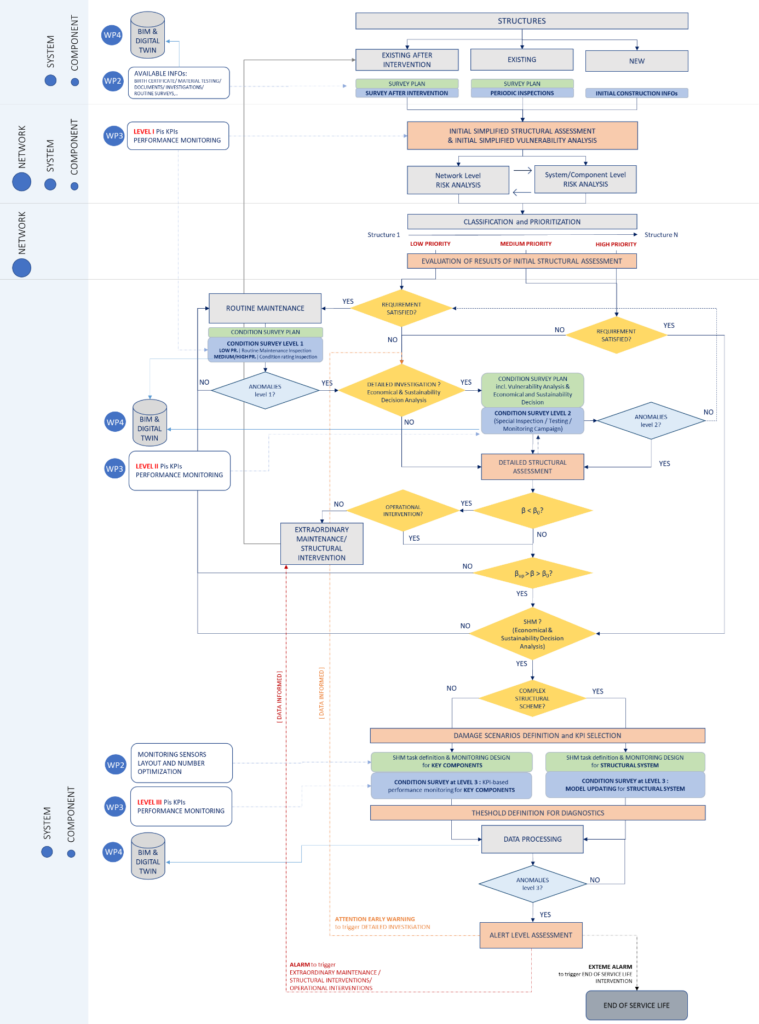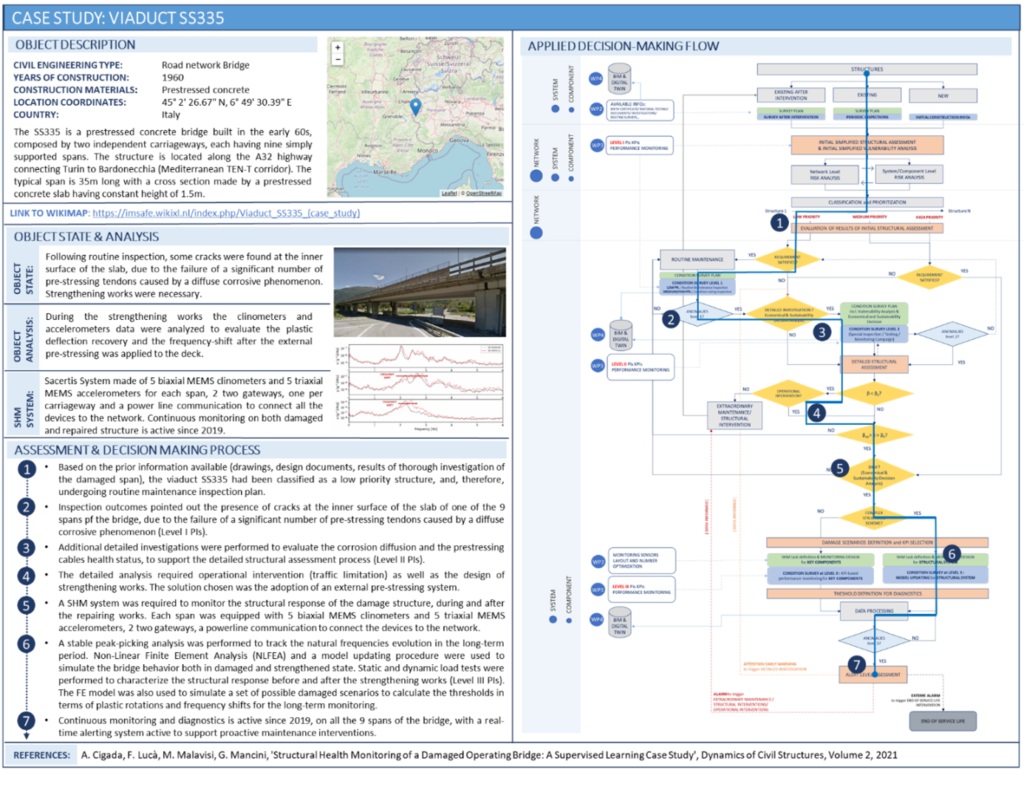The main goals of WP3 are to analyse the current practice of data-informed performance assessment, structural safety evaluation and risk management of infrastructure supported by inspection, monitoring and testing, based on the outcomes of WP1, WP2 and WP4 including direct involvement of the CoP through WP6 and feeding WP5 for the preparation of the mandate for new standards, as well as to develop a proposal for data-informed performance assessment, structural safety evaluation and risk management and proactive maintenance planning for transport infrastructures, to overcome the current barriers using innovative technologies. The proposed methods of safety evaluation, risk management and decision-making regarding maintenance strategy will form the background of the mandate for a standard (CEN) for safety control and maintenance of infrastructures. In addition, the proposed methodology for safety control and decision-making process has been showcased on real examples from TEN-T corridors and regional transport networks.
The project results have been collected in two reports, D3.1 (“appraisal of methods for safety evaluation and risk management”) and D3.2 (“background materials for implementation of decision-making regarding maintenance strategies”), which are also complemented by a proposal for harmonization of terminology.
Appraisal of methods for safety evaluation and risk management methods
Deliverable 3.1 provides a comprehensive review of the presently applied technical, environmental, societal, and economic Key Performance Indicators (KPIs) adopted in existing Bridge Management Systems. This analysis includes the classification of types of infrastructure based on typology, vulnerable zones and vulnerability, the categorization of performance indicators for different levels of assessment (network, object and component level) and, additionally, the list of Key Performance Requirement indicators (KPRs) for bridge and tunnel management systems.
Hence, in order to analyze the state-of-the-art for safety assessment methods and evaluation of the possible inclusion of information from diagnostics of structures (based on data from inspection, monitoring and testing), the definition of condition and performance concepts is thoroughly presented. Starting from an overview of deterioration and damage mechanisms for both bridges and tunnels, attention is given to the principles of limit-state, reliability-based approach and performance modelling, Damage Indicators (Dis) for assessment and the implementation of the condition concept in through-life management. Additionally, principles of performance verification methods of new and existing structures and of data-informed assessment approaches are given and the use of data in performance verification is elaborated.
Deliverable 3.1 also introduces the risk concept, providing a general description of the principles of risk representation, together with the proposal for a generic framework for risk management of infrastructure objects. It also includes the classification of hazards and actions for both bridges and tunnels and an example for the probabilistic and data-informed representation of hazardous events for traffic loads on bridges. As such, several methods for assessment and management of risk for infrastructure networks, objects and components are given, as well as the evaluation of the risk management methods aiming at assuring reliability and safety of infrastructure, currently used in the EU, with specific focus on their capability to include information from diagnostics of structures in the quantification of risks (risk classification).
Lastly, in Deliverable 3.1 an appraisal with regards to standardization is given, including a proposal for a framework for data-informed assessment of transport infrastructure.
Download deliverable 3.1 here.
Decision-making concerning maintenance strategies
Deliverable 3.2 aims to develop background information and practical guidance material as rationale for the mandate for new standards (CEN) for maintenance and control of large infrastructures, such as bridges and tunnels. This objective facilitates the preparation of recommendations for standardization (WP5). This has been performed with an analysis of the minimum maintenance level guaranteed in the different European countries, evaluating the average infrastructures Condition State Classification and the consequent expected damages (reference to WP1 and WP6), based on the real practice in Europe compared to the requirements in the existing standards:

For more information, click here.
For this purpose, Deliverable 3.2 provides an overview of the principles of through-life management and maintenance of infrastructures, with attention to the main maintenance strategies, conservation processes and investigations, evaluations, and decision-making for maintenance activities.
Thus, principles of maintenance of infrastructure are given, as well as a risk-based framework for maintenance management, a classification of the common typologies of maintenance strategy, in terms of acceptance of risk, the activities required and principles for the selection of maintenance strategies.
Moreover, a critical review of Quality Control Plans and maintenance strategies and tactics (proactive vs. reactive strategies, time-based, condition-based, risk-based tactics) adopted by the CoP members in the different European countries has been analyzed, feeding an interactive map on the IM-SAFE
This Interactive Map (wiki-like) contains information of how different countries in Europe deal with KPIs and Risk management method complements the project results. For Wiki map click here.
Specifically, the Condition-based Maintenance approach for bridges is described, providing an overview of the maintenance strategies commonly used for asset management adopted by the CoP in the different European countries. Deliverable 3.2 also focuses on Quality Management (QM) as part of the wider framework of the Asset Management, which aims to ensure that the resulting built structure satisfies the assumptions adopted in the design, emphasizing its application to all levels, processes and activities of an organization. Asset management is a very broad area and includes a lot of processes that are associated with quality management. For the reason of emphasizing QM, QM was primarily highlighted.
Concerning condition survey, instead, a comparison between various methods (inspection, monitoring and testing), assessing the capital and operating costs of the different solutions has been performed, principles of Information Management are given, focusing on information collected in the maintenance and monitoring phase of an infrastructure. A classification for the relevant information for infrastructures is provided and the impact of costs of information on decision-making is presented, together with an analysis of the Value-of-information based decision-making for investigations activities.
Based on the outcomes of WP3 analysis, the IM-SAFE project proposes in Deliverable 3.2 a framework for the data-informed safety assessment highly interrelated with the through-life management of the transport infrastructure. The need for the clarification of the relationship between the available data, the need of assessment and the maintenance strategies has led to the development of a practical decision-making process for asset owners and operators to facilitate proactive maintenance, that overcomes the current barriers (see results of IM-SAFE WP1) and reflects on the most recent developments of condition survey technologies and structural diagnostics (see results of IM-SAFE WP2 and WP4), with the aim to reduce the risks of sudden collapse and to minimise the lifecycle cost of asset management while ensuring the required service level and quality of the infrastructures are achieved. The decision-making process has been differentiated based on the infrastructure Condition State Classification (see results of IM-SAFE WP2) and takes into consideration the strategic role of each infrastructure within the road network.
It should be highlighted that this proposal has been developed together with the CoP direct involvement (see results of IM-SAFE WP6).

For more information on the assessment flow, click here.
A practical application of the decision-making process described above to real case scenarios located on TEN-T corridors and regional transport networks is provided. The selected case studies are representative of how the proposed decision-making flow is already applied, at different levels, in current practice experiences. To showcase this application, a template has been created in order to summarize the information on each case study and to describe visually and clearly some of the possible paths covered in the decision-making process.

An example for the application of the assessment flow to a case study is provided here.
In conclusion, Deliverable 3.2 provides an appraisal with regards to standardization: a review of current frameworks for Quality Control Plans, a proposal of framework for Preventive Maintenance Procedures and a proposal of framework for data-informed decision-making for safety and risk management of the European transport infrastructures, aiming at a sustainable and efficient management of both single bridges and a network of bridges, are given.

